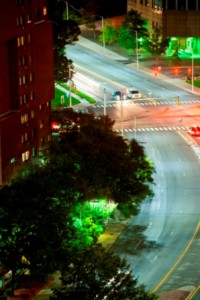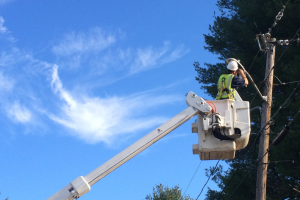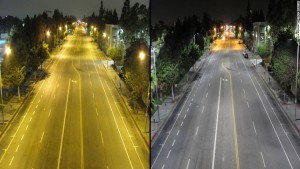AMA Policy, UConn Professor Raise Concerns About Municipal Conversions to LED Lighting
/An article authored by UConn professor of Community Medicine and Health Care Richard G. Stevens, which highlights red flags being raised by the American Medical Association regarding the safety of LED lighting being installed in cities around the country, is gaining notice. The article first appeared on an international website, theconversation.com, which features articles researched and written by college faculty from the U.S. and around the world. The site’s tagline, “Academic rigor, journalistic flair,” reflects its approach. The article has since been re-published on the CNN website, and it gaining traction on dozens of other internet sites.
The article revolves around a policy statement issued by the AMA this month that suggests “conversions to improper LED technology can have adverse consequences.” Stevens, who has written about the health risks of electric lighting for more than two decades, indicates that the policy statement comes "in response to the rise of new LED street lighting sweeping the country.” 
The new "white" LED street lighting which is rapidly being retrofitted in cities throughout the country has two problems, according to the AMA, Stevens highlights. “The first is discomfort and glare. Because LED light is so concentrated and has high blue content, it can cause severe glare, resulting in pupillary constriction in the eyes. Blue light scatters more in the human eye than the longer wavelengths of yellow and red, and sufficient levels can damage the retina. This can cause problems seeing clearly for safe driving or walking at night.” The AMA goes on to point out that blue-rich LED lighting can decrease visual acuity and safety, resulting in concerns and creating a road hazard.
 In addition to its impact on drivers, the AMA notes that blue-rich LED streetlights operate at a wavelength that most adversely suppresses melatonin during night. It is estimated that white LED lamps have five times greater impact on circadian sleep rhythms than conventional street lamps, the AMA indicated. Recent large surveys, according to the AMA, found that brighter residential nighttime lighting is associated with reduced sleep times, dissatisfaction with sleep quality, excessive sleepiness, impaired daytime functioning and obesity.
In addition to its impact on drivers, the AMA notes that blue-rich LED streetlights operate at a wavelength that most adversely suppresses melatonin during night. It is estimated that white LED lamps have five times greater impact on circadian sleep rhythms than conventional street lamps, the AMA indicated. Recent large surveys, according to the AMA, found that brighter residential nighttime lighting is associated with reduced sleep times, dissatisfaction with sleep quality, excessive sleepiness, impaired daytime functioning and obesity.
The AMA points out that “converting conventional street light to energy efficient LED lighting leads to cost and energy savings, and a lower reliance on fossil-based fuels. Approximately 10 percent of existing U.S. street lighting has been converted to solid state LED technology, with efforts underway to accelerate this conversion.”
Although no comprehensive list is available, among the communities in Connecticut making the switch to LED lighting are Stamford, Plainville, East Hartford, Southington, and Berlin, according to published reports. Cheshire launched a streetlight replacement program earlier this year, indicating that “the new LED fixtures will provide the appropriate amount of lighting for locations across the town and will focus light directly downward on the sidewalks and roadway. The fixtures have a ten-year product warranty, but are anticipated to have a much longer life. The project is expected to be completed in July 2016.”
"Despite the energy efficiency benefits, some LED lights are harmful when used as street lighting," AMA Board Member Maya A. Babu, M.D., M.B.A. "The new AMA guidance encourages proper attention to optimal design and engineering features when converting to LED lighting that minimize detrimental health and environmental effects."
The AMA encourages communities to minimize and control blue-rich environmental lighting by using the lowest emission of blue light possible to reduce glare. Stevens, however, says that “the AMA's recommendation for CCT below 3000K is not quite enough to be sure that blue light is minimized. The actual spectral irradiance of the LED -- the relative amounts of each of the colors produced -- should be considered, as well.”
Stevens concludes that “there is almost never a completely satisfactory solution to a complex problem. We must have lighting at night, not only in our homes and businesses, but also outdoors on our streets. The need for energy efficiency is serious, but so too is minimizing human risk from bad lighting, both due to glare and to circadian disruption. LED technology can optimize both when properly designed.”
The Hartford Courant reported last year that ESCO Energy Services is working with the Connecticut Conference of Municipalities to implement its municipal Street Light LED Conversion Program to buy the current streetlights from utilities and replace them with more efficient LED fixtures.
Stevens proposed in 1987 what was then seen as a radical new theory that use of electric lighting, resulting in lighted nights, might produce "circadian disruption" causing changes in the hormones relevant to breast cancer risk, according to the UConn Health website. Accumulating evidence has generally supported the idea, the site indicates, and it has received wide scientific and public attention. For example, his work has been featured on the covers of the popular weekly Science News (October 17, 1998) and the scientific journal Cancer Research (July 15, 1996). His most recent paper, “Shift work as a harbinger of the toll taken by electric lighting,” was published in Chronobiology International, The Journal of Biological and Medical Rhythm Research, in January 2016.
 The Conversation website is a collaboration between editors and academics to provide "informed news analysis and commentary that’s free to read and republish." It launched as a pilot project in the U.S. in October 2014 after starting in Australia in March 2011 and the UK in May 2013. Boston University’s College of Communication is are hosting the operation in the U.S.
The Conversation website is a collaboration between editors and academics to provide "informed news analysis and commentary that’s free to read and republish." It launched as a pilot project in the U.S. in October 2014 after starting in Australia in March 2011 and the UK in May 2013. Boston University’s College of Communication is are hosting the operation in the U.S.
 PHOTO: Traditional street lighting (left) vs. LED lighting (right).
PHOTO: Traditional street lighting (left) vs. LED lighting (right).





























